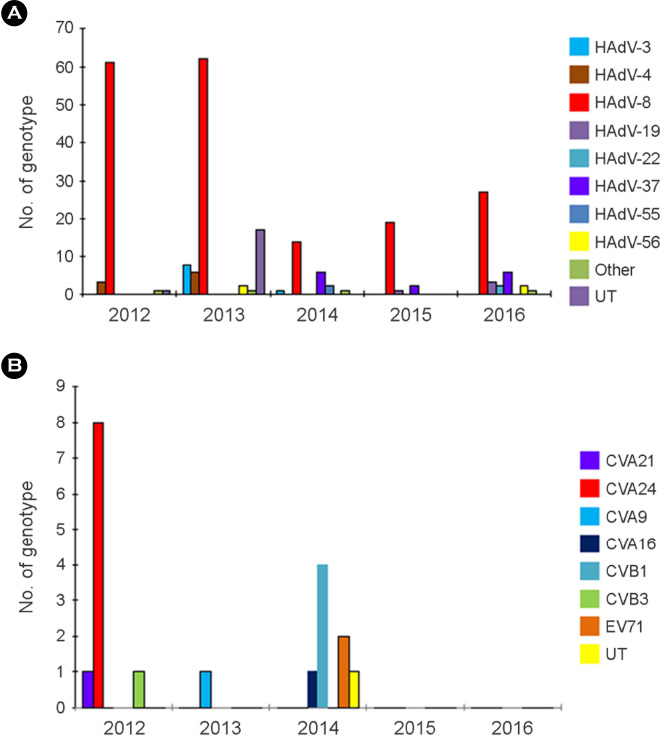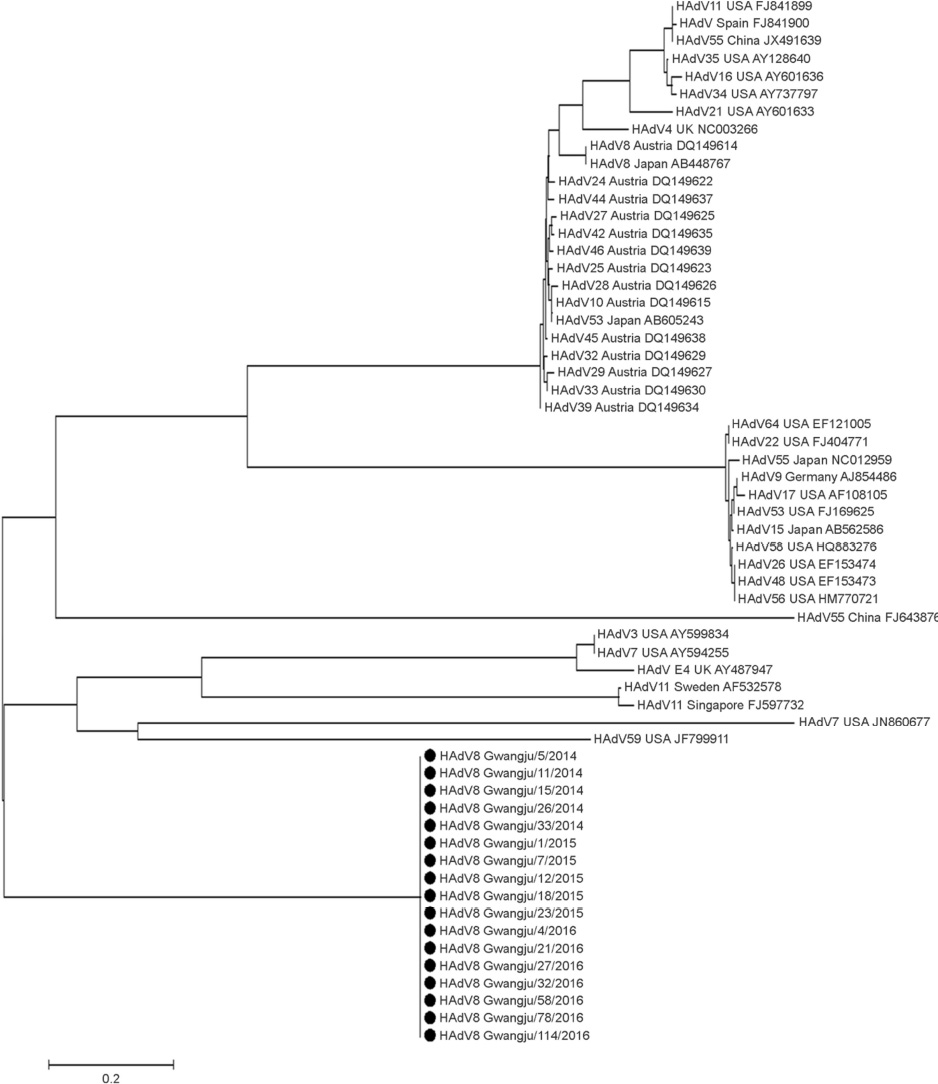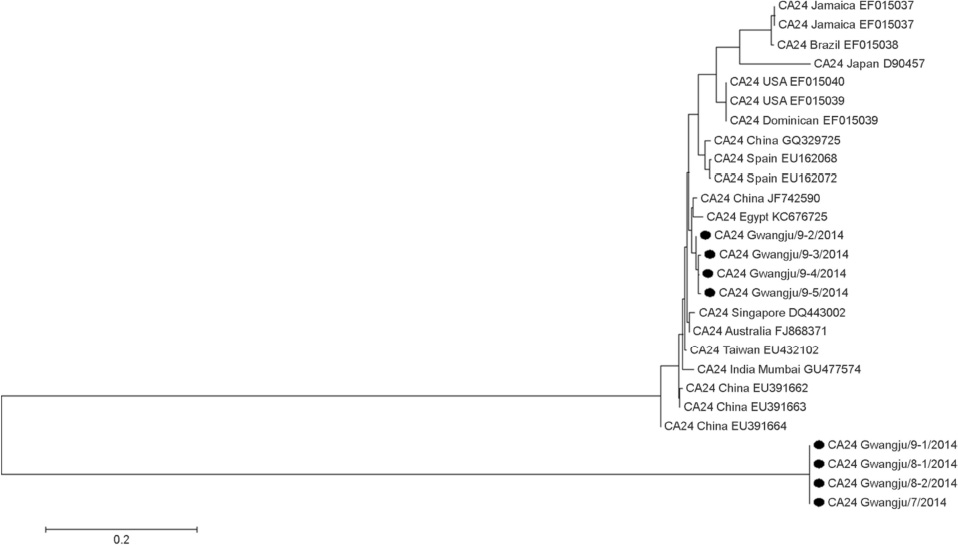J Bacteriol Virol.
2018 Jun;48(2):59-66. 10.4167/jbv.2018.48.2.59.
Molecular Epidemiology of Viral Conjunctivitis in the Southern Region of South Korea, 2012–2016
- Affiliations
-
- 1Health and Environment Research Institute of Gwangju, Gwangju, Korea. jkchung@korea.kr
- 2Kim Jang Hoon Eye Clinic, Gwangju, Korea.
- 3Dr. Lee Eye Clinic, Gwangju, Korea.
- 4St. Mary Eye Clinic, Gwangju, Korea.
- 5Moo-Deung Eye Clinic, Gwangju, Korea.
- 6Department of Microbiology, Chonnam National University School of Medicine, Gwangju, Korea.
- KMID: 2414856
- DOI: http://doi.org/10.4167/jbv.2018.48.2.59
Abstract
- Epidemic keratoconjunctivitis (EKC) and acute hemorrhagic conjunctivitis (AHC) are common diseases caused by human adenoviruses (HAdV) and enteroviruses, respectively, in South Korea. However, there are limited studies on the molecular epidemiology of viral conjunctivitis in South Korea. The main objective of this study was to characterize the genotypes of adenoviruses and enteroviruses causing viral conjunctivitis in the southwest region of South Korea. We collected conjunctival swabs from 492 patients with suspected cases of viral conjunctivitis from 6 ophthalmic hospitals in Gwangju Metropolitan City, in South Korea, between 2012 and 2016. Of the 492 samples tested, HAdVs and enteroviruses were detected in 249 samples (50.6%) and 19 samples (3.9%), respectively. The genotype analysis detected HAdV-8 in 183 samples (73.5%), HAdV-37 in 14 samples (5.6%), and HAdV-3, and HAdV-4 in 9 samples (3.6%) each. We detected coxsackievirus A24 (CVA24) and coxsackievirus B1 (CVB1) in 8 samples (42.0%) and 4 samples (21.0%), respectively. We also reported for the first time HAdV-56-infected cases of EKC in South Korea. Furthermore, we found three cases of coinfection with HAdV and enterovirus genotypes in our samples. HAdV-8 and CVA24, the main causes of EKC and AHC, respectively, worldwide, were also found to be the predominant genotypes in our study.
MeSH Terms
Figure
Reference
-
1. O'Brien TP, Jeng BH, McDonald M, Raizman MB. Aucte conjunctiviris: truth and misconceptions. Curr Med Res Opin. 2009; 25:1953–1961.2. CDC conjunctivitis. accessed 2017.5.20. https://www.cdc.gov/conjunctivitis/clinical.html.3. Durand ML, Weber DJ, Rutala WA. Healthcare-associated eye infections. In : Mayhall CG, editor. Hospital epidemiology and infection control. 4th ed. Philadelphia, PA: Lippincott Williams and Wilkins;2012. p. 352–364.4. Craighead JE. Adenoviruses. Pathology and Pathogenesis of Human Viral Diseases. Academic Press;2000. p. 189–201.5. Aoki K, Kato M, Ohtsuka H, Ishii K, Nakazono N, Sawada H. Clinical and aetiological study of adenoviral conjunctivitis, with special reference to adenovirus type 4 and 19 infections. Br J Ophthalmol. 1982; 66:776–780.
Article6. Aoki K, Kawana R, Matsumoto I, Wadell G, de Jong JC. Viral conjunctivitis with special reference to adenovirus type 37 and enterovirus 70 infection. Jpn J Ophthalmol. 1986; 30:158–164.7. Aoki K, Tagawa Y. A twenty-one year surveillance of adenoviral conjunctivitis in Sapporo, Japan. Int Ophthalmol Clin. 2002; 42:49–54.
Article8. Melendez CP, Florentino MM, Martinez IL, Lopez HM. Outbreak of epidemic keratoconjunctivitis caused by adenovirus in medical residents. Mol Vis. 2009; 15:557–562.9. Tavares FN, Campos Rde M, Burlandy FM, Fontella R, de Melo MM, da Costa EV, et al. Molecular characterization and phylogenetic study of coxsackievirus A24v causing outbreaks of acute hemorrhagic conjunctivitis (AHC) in Brazil. PLoS One. 2011; 6:e23206.
Article10. Ghazali O, Chua KB, Ng KP, Hooi PS, Pallansch MA, Oberste MS, et al. An outbreak of acute haemorrhagic conjunctivitis in Melaka, Malaysia. Singapore Med J. 2003; 44:511–516.11. Oh MD, Park S, Choi Y, Kim H, Lee K, Park W, et al. Acute hemorrhagic conjunctivitis caused by coxsackievirus A24 variant, South Korea, 2002. Emerg Infect Dis. 2003; 9:1010–1012.
Article12. Crawford-Miksza LK, Nang RN, Schnurr DP. Strain variation in adenovirus serotypes 4 and 7a causing acute respiratory disease. J Clin Microbiol. 1999; 37:1107–1112.
Article13. Tabbara KF, Omar N, Hammouda E, Akanuma M, Ohguchi T, Ariga T, et al. Molecular epidemiology of adenoviral keratoconjunctivitis in Saudi Arabia. Mol Vis. 2010; 16:2132–2136.14. Adloch C. Auswertung der bundesweit übermittelten Meldedaten zu Adenovirus konjunktivitiden. Epidemiologisches Bulletin. 2010; 37.15. Jun EJ, Won MA, Ahn J, Ko A, Moon H, Tchah H, et al. An antiviral small-interfering RNA simultaneously effective against the most prevalent enteroviruses causing acute hemorrhagic conjunctivitis. Invest Ophthalmol Vis Sci. 2011; 52:58–63.
Article16. Ayoub EA, Shafik CF, Gaynor AM, Mohareb EW, Amin MA, Yassin AS, et al. A molecular investigative approach to an outbreak of acute hemorrhagic conjunctivitis in Egypt, October 2010. Virol J. 2013; 10:96.
Article17. Huang G, Yao W, Yu W, Mao L, Sun H, Yao W, et al. Outbreak of Epidemic Keratoconjunctivitis Caused by Human Adenovirus Type 56, China, 2012. PLoS ONE. 2014; 9:e110781.
Article
- Full Text Links
- Actions
-
Cited
- CITED
-
- Close
- Share
- Similar articles
-
- Molecular characterization and phylogenetic analysis of pseudorabies virus variants isolated from Guangdong province of southern China during 2013–2014
- A Study for Viral Identification of Acute Viral Conjunctivitis
- Delayed Epithelial Ingrowth Caused by Viral Conjunctivitis after LASIK
- Ocular allergy in the Asia Pacific region
- A Case of Monocular Gonococcal Conjunctivitis in an Adult Male




